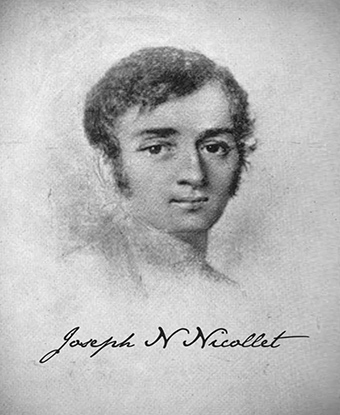Last updated: August 31, 2020
Person
Joseph Nicollet

Public Domain
". . . a prodigious quantity of blood-red stone . . . mixed with the fragments of the old red sandstone that are sliding from the hill, gives to the prairie an extraordinary aspect almost impossible to describe." -Joseph Nicollet, July 5th 1838 journal entry
Born in 1786 in France, Joseph Nicollet excelled in astronomy, mathematics, and geography. He found employment at the Paris Observatory and built a strong reputation for his expertise. However, the economic and political unrest of 1830s France convinced him to try to make a name for himself in the United States instead.
Once in America, Nicollet was determined to embark on a scientific expedition to accurately map the area surrounding the upper Mississippi River. He secured financial support from the wealthy Chouteau family in St. Louis and went on to lead three expeditions between 1836 and 1839. In 1836-1837, he went up the Mississippi to Lake Itasca and then along the St. Croix River. Then in 1838, he traveled from Fort Snelling to the Pipestone Quarries, where he met Indigenous people quarrying pipestone.
On July 1st, he wrote of camping near Indigenous families on their way to the quarries, and that "It is at this time that the nations of the Missouri make their pilgrimage to the red stone, and were it not for the fear of smallpox, we would probably already have encountered many of their bands." He also noted that the pipestone had typically been exposed at the surface, but by the time of his writing in 1838, he observed that Indigenous quarriers "...have regretted that the red stone is exhausted at all the places where it can be extracted without difficulty. To reach it now, it is necessary to remove a layer of old red sandstone [Sioux quartzite] 4 1/2 feet thick."
In reference to the pipestone itself, Nicollet wrote, "The discovery of the red earth is due to the passage of animals [buffalo] which hollowed out a deep pathway, as they do in the regions of seasonal migration where they try always to take the same route. The pathway revealed the surface of the red rock. One can imagine, then, in nations for whom the pipe is among the most important of necessary objects what a windfall it was to be provided with a soft stone of their favorite color, suitable for making pipes, in an immense land where there is no other workable rock."
While at the quarries, he and members of his expedition (John C. Fremont, Charles Geyer, Joseph Renville Jr., J. Eugene Flandin, and Joseph LaFromboise) carved their names into a rock near the top of the falls. Twenty years later, that same rock was used as the center marker inside of the 1-square mile boundary of Pipestone Reservation. The rock and the inscriptions of their initials can still be seen today on the Circle Trail.
Finally in 1839, Nicollet led an expedition across the stretch of land between the Missouri and upper Mississippi rivers. His journeys resulted in the influential book, Map of the Hydrographical Basin of the Upper Mississippi, which was a remarkably accurate record of an area more than half the size of Europe. His journals tell us that he learned much from the inhabitants of this region, particularly the Dakota and Ojibwe people. Unlike other maps created at the time, Nicollet's maps recorded Indigenous place names of locations throughout the region.
In addition to the infrastructure that Nicollet's name today (roads, a city, a county, etc.), Harold Torness (a banker and Nicollet-enthusiast) initiated the effort in cooperation with the Dakota people to build a tower and interpretive center to memorialize Nicollet in 1991. From the top of the tower in Sisseton, visitors can view North Dakota, South Dakota, Minnesota, and the Coteau de Prairies.
Joseph Nicollet died in 1843 in Washington D.C. after a long battle with illness. His tombstone reads "He will triumph who understands how to conciliate and combine with the greatest skill the benefits of the past and the demands of the future."
His journals are available for free online.
**All quotes from Joseph N. Nicollet on the Plains and Prairies: The Expeditions of 1838-39 with Journals, Letters, and Notes on the Dakota Indians, Translated from the French and edited by Edmund C. Bray and Martha Coleman Bray.
